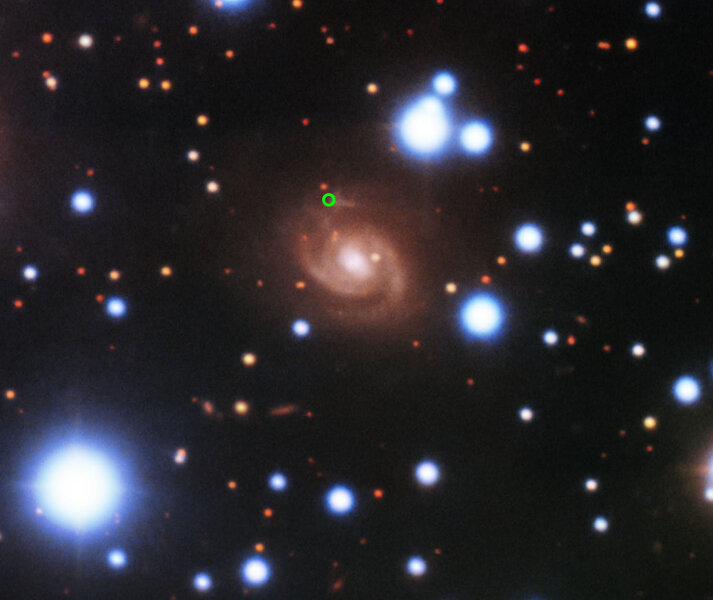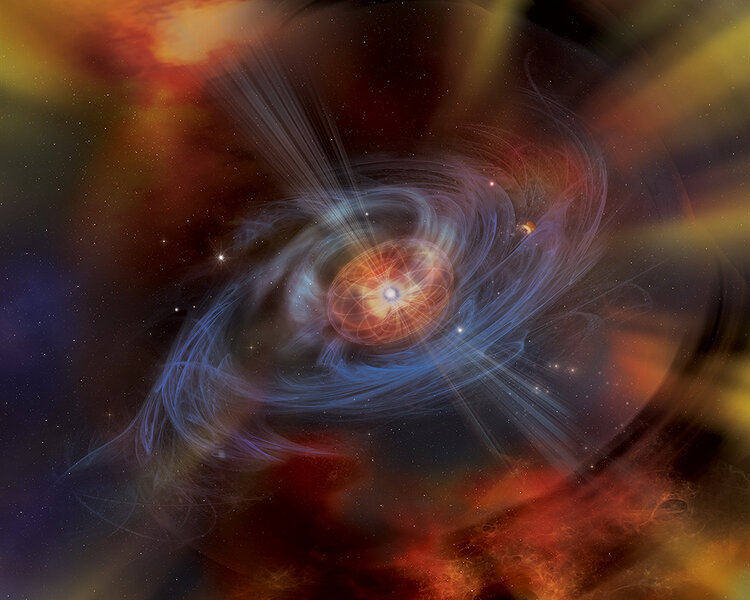Create a free profile to get unlimited access to exclusive videos, sweepstakes, and more!
A new Fast Radio Burst discovery only deepens the mystery of these powerful blasts of energy

Just what the heck are fast radio bursts?
Let me be clear right off the bat: No one knows. But we just got a step closer to understanding them, which infuriatingly, also means things are even more complicated than they were before.
Fast radio bursts, or FRBs, are one of the more enduring cosmological mysteries today. They are as advertised: Very fast (usually a few milliseconds at most) and very powerful flashes of radio emission from the sky. Lots of things out there can emit radio waves: Planets (Jupiter is a big source), the Sun, stars, exploding stars, galaxies, dust, you-name-it. But these tend to emit radio waves persistently. Even things known to flash in radio waves (like pulsars, which are rotating neutron stars) flash over and over again with a pretty well understood periodicity.
FRBs aren't like that. The first ones found were one-and-done, flashing once very briefly and then disappearing. That's irritating, because it's hard to learn anything about them. Then some were discovered to repeat, flashing multiple times, though without any sort of obvious period (in other words flashing at what seem like random intervals). That's interesting, because that means whatever causes repeating bursts isn't getting destroyed in the process; that rules out things like exploding stars.
Figuring out where they are in the sky is hard, and out of the hundreds of FRBs detected, only a few have been localized — and by "few", I mean four. Just four. And of those four just one — FRB 121102 — is a repeating FRB. It was found to be located in a distant dwarf galaxy billions of light years away, and a weird galaxy at that: It's irregularly shaped and appears to be low metallicity, which is astronomer speak for "not having many heavy elements".
And now things are even more confusing. A new FRB, called FRB 180916.J0158+65 (after the date it was first seen, 16 September 2018, and its coordinates on the sky), has been localized, and the source was, yet again, a surprise: A spiral galaxy about 500 million light years away.
And that's weird. Well, different. This galaxy has five times the metallicity of the dwarf galaxy hosting FRB 121102, and is 100 times as massive! So yeah, they're very different. Galaxies with different metallicities tend to have different star formation histories, and even different kinds of stars in them. This new discovery seems to imply that this doesn't make much difference as far as FRBs are concerned. They're happy to appear in either.
Not only that, but by carefully examining the radio signals from the two bursts, astronomers have determined that FRB 121102 comes from a highly magnetized environment, like that around a neutron star, but the new one, FRB 180916.J0158+65, has an environment that is one-thousandth as magnetized! So if it comes from a neutron star, it comes from one with a very weak field.
That's just really strange. Neutron stars are weird beasts, and much of their behavior, like periodic flashes of energy, and huge outbursts that blast out vast amounts of energy, are tied to their powerful magnetic fields. Having an FRB associated with one that has a very weak magnetic field is, well, bizarre.
So this new discovery is important, in that it shows that FRBs are diverse, but it's also somewhat aggravating, in that it does complicate things. But then, it's the Universe that's complicated, and we're just trying to figure it out. That happens one step at a time, and sometimes it feels like we're stumbling around in the dark. But if you walk enough, you're bound to bump into something important at some point. So we keep walking.
It's still early days with understanding FRBs. It reminds me of gamma-ray bursts, which were also rare and hard to locate. Then, quite suddenly, we were able to start pinning them down, and quite rapidly after that they become a lot more understandable… but also came from a number of different kinds of objects. It wouldn't surprise me a bit if FRBs are the same.
This newly found repeating FRB is a step in the process, not the goal. We need to localize lots more, get deeper images, observe them at multiple wavelengths, track them for years, and in ding so start to categorize them. Once we have enough examples with enough differing characteristics we'll start to truly understand them. Until then, well, we just need to keep our eyes on the skies.




























